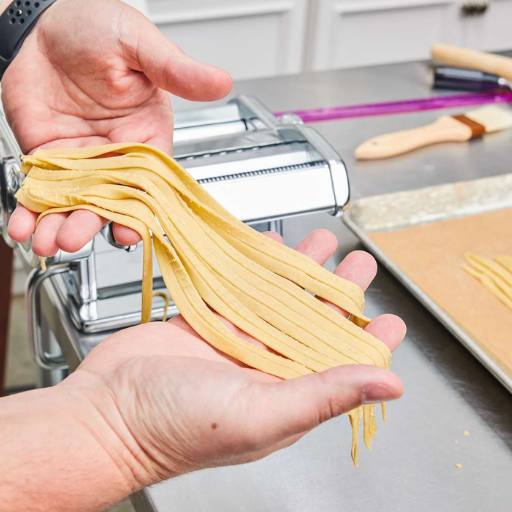When it comes to food, nothing beats the taste of fresh pasta that is made at home, and to enjoy this treat, you will require a good pasta maker in your kitchen. If you want to take your cooking experience to another level and discover new foods, then having the right pasta maker works for any chef, regardless of their experience. Through this guide, we will help you understand different types of pasta makers, the main features to focus on when purchasing one, and how to make the right decision based on your needs and preferences. As soon as you finish reading this piece of writing, you will be knowledgeable enough about selecting a perfect pasta maker that can make every meal unforgettable.
What is a pasta maker, and how does it work?
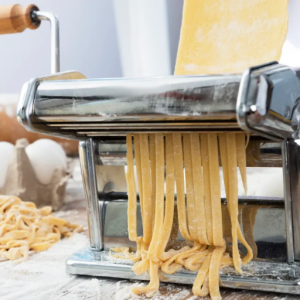
Image source: https://reviewed.usatoday.com/
A pasta maker is a kitchen appliance that makes producing fresh pasta at home easier. It typically flattens and cuts the dough into different dimensions to create various shapes. To use a pasta maker, you will need some prepared dough balls passed through rollers to form them into thin sheets later. The breadth of the sheet can be adjusted by regulating roller settings. After attaining the appropriate thickness, the dough is fed through cutters that fashion it into spaghetti, fettuccine, or lasagna. On top of that, some sophisticated models have an extrusion function, which gives a more excellent range of shapes than before.
Understanding manual versus electric pasta machines
When thinking about whether to buy a manual or an electric pasta maker, the upsides and downsides of every kind must be known.
Hand-crank-operated manual pasta machines are usually more inexpensive than electric ones. They provide excellent guidance in making spaghetti, allowing users to feel the dough as they roll it out. Nevertheless, using a hand-operated machine may be exhausting work, demanding more time and energy, especially when larger quantities of pasta are needed.
For instance, electric machines cut on time spent making pasta since they automate some aspects of pasta-making. Sometimes, they come with different attachments and settings for various pasta. Though costly, these machines also save one much time and physical exertion. The only drawback is the lack of tactile control over the dough, which could be possible using manual machines.
Ultimately, depending on your cooking preferences, budget constraints, and how frequently you anticipate preparing homemade pasta will determine whether you go for a manually operated or an electrically powered machine for this purpose.
The critical components of a pasta maker machine
Knowing the parts of a pasta maker machine will give you the best results from your appliance. These are the main components:
- Rollers: Rollers are used to flatten and stretch out the dough. A hand crank operates manual machines, while motors power electric machines.
- Cutters: As soon as it’s flattened, the dough passes through cutters that create different pasta shapes. Examples include spaghetti, fettuccine, and lasagna cutters.
- Adjustment Knob: This is for controlling how thick or thin you want your pasta to be by altering the space between two rollers. It helps achieve the desired texture and consistency.
- Extrusion Dies/Discs: These attachments, found mainly on electric pasta machines, enable extruding various forms (penne, fusilli, rigatoni) by pushing dough through specific molds.
- Mixing Chamber: In fully automated machines, all ingredients come together and are kneaded before being shaped into noodles.
Knowing about these parts ensures that one’s pasta-making experience is filled with high-quality output, which can be done right at home using reliable devices.
How does a pasta roller and cutter operate?
A sequence of simple steps guides the operation of a pasta roller and cutter. First, you make the dough and divide it into manageable pieces. These parts are then passed through rollers that compress and stretch them to the needed thinness. An adjustment knob allows for control of thickness levels. When properly flattened, the dough is fed into cutters, which slice it into different shapes, such as spaghetti or fettuccine. In manual machines, a hand crank is turned to move the dough through both rollers and cutters, while in electric ones, this process is automated by a motor. The outcome is uniform-shaped and textured pasta that can be cooked.
How do you choose the best pasta makers of 2024?
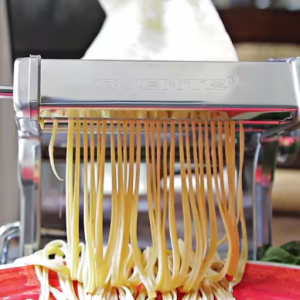
In selecting the best pasta makers in 2024, there are a few things you need to bear in mind; first is whether you want a manual or an electric model- manual gives more control, but electric ensures convenience. Check the machine’s versatility with attachments like cutters and extrusion dies for various pasta shapes. Look for strong materials such as stainless steel construction which guarantees long life span due to durability. User reviews together with ratings can give clue on reliability as well ease of use. Finally, consider your budget against warranty plus customer support services provided by the manufacturer so that all these factors will guide one towards choosing a suitable pasta maker according to his/her culinary requirements.
Factors to consider: type of pasta and usage
When choosing a pasta maker that suits you best, consider the specific varieties of pasta you want to prepare and how frequent your usage will be. For example, if one makes pasta occasionally and likes to have complete control over the process, they may opt for a manual machine. It allows for different shapes and thickness adjustments, which is great for gourmet cooking. Conversely, an electric pasta maker is designed for heavy-duty or large-scale production where speed matters most. Apart from saving time and energy during use, some models can also knead dough automatically, making them easy to use and highly efficient. Therefore, one must match their intended usage with the appropriate type of spaghetti-making device to achieve consistent quality results each time they cook.
Reviewing the top pasta maker brands
Marcato
In the world of pasta makers, Marcato is a well-known name that offers high-quality manual machines like the Marcato Atlas 150. These Italian-made machines are made using strong stainless steel that is built to last. The Marcato Atlas can be adjusted for different thicknesses and has interchangeable attachments for various shapes, which allows for versatility in making different types of pasta. Its solid construction and smooth operation have won over users who use it at home or in professional kitchens.
Philips
Electric pasta makers do not get any better than those offered by Philips, including their Pasta and Noodle Maker. These machines are designed to save time with features such as automatic mixing, kneading, and dough extruding within minutes. To cater to different types of pasta, they come with multiple-shaped discs. Ease of use and reliable performance make Philips a favorite choice, especially because some parts can be washed in a dishwasher, thus saving even more time.
Imperia
Another Italian brand, Imperia, specializes in both manual and electric versions of pasta makers, such as iPasta and Electric models, respectively, under their Pasta Maker Machine lineup, but all renowned equally for being strongly built while operating smoothly. Cutting accessories are also numerous so that one can make any size or shape desired thanks to this flexibility provided by Imperia machines in addition to which it has been praised by consumers who love traditional design concepts applied here, plus overall robustness displayed during use making them feel closer towards getting actual authentic pasta making experience every time they choose these among others available options out there today.
For many people who love pasta—whether beginners or experts—the three brands Marcato, Philips, and Imperia are considered to be among the best choices primarily because their products offer the high quality, reliability, and flexibility required at all stages. More importantly, what sets them apart from other competitors lies mainly in how much each brand understands the needs of its customers when it comes to making this type of food.
Comparing manual pasta and electric pasta maker options
When it comes to comparing manual and electric pasta manufacturers, there are several factors to consider:
Ease of Use:
The physical labor required to roll and cut the dough using items such as the Marcato Atlas 150 or Imperia Pasta Maker Machine makes them a hands-on option. The process can be rewarding but may take more time and effort than other methods. On the other hand, electric models like Philips Pasta and Noodle Maker knead dough, mixed it together with water, and extrude this mixture all through automation, hence reducing the work done by human beings significantly.
Versatility:
Many manual machines have different attachments that enable people to produce various shapes, thicknesses, etc., which are not different from electric counterparts, including those made by brands like Philips, which come with multiple shape discs for different types of pasta. However, sometimes, these machines limit customization more than others do.
Durability and Maintenance:
Commonly, machines that require more physical input are known to last longer. This can apply when discussing traditional strong constructions represented by products from Marcato or Imperia, which only need proper maintenance practices to serve someone for many years, unlike others. For instance, washing parts manually during cleaning could be tiresome, though necessary. In contrast, dishwasher-safe components plus simplified assembly found in appliances such as those manufactured by Philips make their users’ lives easier during maintenance. Still, internally, they might not match up to the durability levels exhibited externally, especially electrical devices.
Cost:
Generally speaking, most manual options tend to cost less than most electrical ones; thus, one should first consider whether they want convenience over saving money.
In conclusion, if a person likes cooking things themselves, following old customs, or simply wants something done quickly without putting too much effort, then he/she will go for a Manual Pasta maker. At the same time, an Electric one is perfect for anyone who prefers getting things done fast.
How to make the perfect pasta dough?
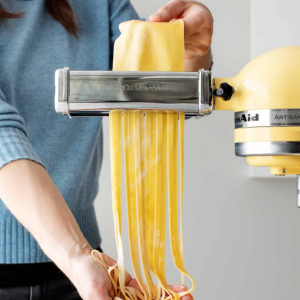
Simple ingredients and the proper technique are needed to make perfect pasta dough. Start by sifting two cups of all-purpose flour onto a clean surface, creating a well in the middle. Crack three large eggs into the well and add a pinch of salt. Stirring with a fork, gradually work the flour into the eggs until they form a shaggy dough. Knead the dough by hand for 10 minutes or until smooth and elastic. If it feels too dry, add water drop by drop; if it is too wet, dust it with more flour. Cover with plastic wrap and rest for 30 minutes before rolling to the desired thickness for the chosen pasta shapes.
Ingredients needed for fresh pasta
To make fresh pasta, here’s what you need:
- 2 cups of all-purpose flour (plus extra for dusting)
- Three large eggs
- A pinch of salt
- Optional: 1 tablespoon of olive oil for added richness
These ingredients combine to form a versatile and delicious pasta dough that can be used in many dishes.
A step-by-step guide to mixing and kneading dough
- Prepare your ingredients: Measure 2 cups of all-purpose flour, three large eggs, a pinch of salt, and a few drops of water if necessary.
- Form a well in the flour: Sift your all-purpose flour onto a clean work surface and shape it into a mound. Use your fingers or the back of a spoon to create a well in the mound’s center, ensuring the walls are high enough to hold the eggs.
- Add the eggs and salt: Crack three large eggs into the well and sprinkle over them with a pinch of salt.
- Incorporate the flour gradually: Slowly mix the eggs and salt with a fork or your fingers, pulling in flour from the sides of the well as you go along. Mix until you have something resembling shaggy dough.
- Start kneading: Once most of the flour is incorporated and comes together as a dough, begin kneading with your hands. To do this, press down on it with the heel of one hand, then push forward so that it stretches out before folding back over itself; give it a slight rotation each time.
- Adjust dough consistency: If the dough is too sticky or dry during the kneading process, add a few drops of water and/or sprinkle more flour.
- Continue kneading: Knead for about ten minutes until smooth elastic; it should spring back when poked.
-
Let dough rest: Shape ball, wrap tightly using plastic wrap, and let rest for a minimum of half an hour at normal room temperatures; this allows gluten fibers within to relax, making it easier to roll out later, etcetera.
By following these steps, you will end up with well-mixed pasta dough that has been properly needled—ready for rolling into various shapes before cooking.
Tips for ensuring a smooth and elastic pasta dough
- Choose the correct flour: Use flours with higher protein content, such as semolina or ’00’ flour, which develops gluten structure for elasticity.
- Hydration factor: Maintain the right egg-to-flour ratio. Eggs are responsible for the moisture and fat content that makes dough smooth and tender, so adjust by adding water or more flour during mixing and kneading.
- Kneading technique: The kneading process should be done correctly. For about ten minutes, knead the dough vigorously to activate the gluten formation necessary for its stretchiness; it should appear sleek with slight stickiness but not clingy.
- Resting stage: Wrap the dough in plastic wrap and let it rest for at least half an hour. This will help relax the gluten strands, making it easy to roll out later.
- Room temperature ingredients: Always work with room temperature eggs because they blend well into other components, producing a soft mixture.
-
Consistent environment: Do not allow your kitchen environment to become too dry or moist, as these conditions can alter the consistency of the dough.
How do you use a pasta maker machine?
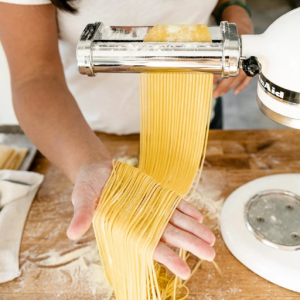
To use a pasta maker machine, carry out these steps:
- Prepare the dough: Cut rested dough into smaller portions for convenience when working with it.
- Adjust the machine: Set the pasta maker to its widest setting.
- Flatten the dough: Sprinkle some flour on rolled-out pieces of dough and make them flat and oblong.
- Feed the dough through the machine: Pass the flattened dough through rollers starting from the widest setting. Fold over and repeat several times until an even thickness is achieved.
- Thin down the dough gradually: Lower the settings of your machine each time so that you can get thinner sheets every now and then, as well as pass each sheet until you achieve the desired thinness.
- Pasta-cutting: Fix the appropriate cutting attachment onto this device before feeding the thin sheets to obtain any preferred shape for noodles, spaghetti-like tagliatelle, etcetera.
- Pasta drying: Spread cut pieces out somewhere airy till they firm up slightly but not too hard before cooking or storing them up altogether
By sticking with these instructions, one will be able to maximize the utilization of their pasta maker machine, resulting in silky smoothness throughout all cuts made uniformly on each strand produced, thereby ensuring even cooking when boiled later on as well.
Setting up your pasta machine for the first time
When you set up a pasta machine for the first time, some steps must be followed to guarantee its best performance. The initial thing to do is read the particular user manual of this machine cautiously to know its parts and how they are put together. Wipe clean every detachable part with wet material to eradicate any dirt left during manufacture, but avoid dipping the whole unit into water. Affix the pasta maker onto an uncontaminated and firm working area with the clamp provided, ensuring it is fastened tightly enough not to move when used. Enlarge rollers by adjusting them to their widest setting, then pass them through a small piece of dough several times so they can rotate easily, hence lubricating them while removing any other particles remaining behind. Once these steps are done, your pasta machine will be ready for use, enabling you to start making homemade paste quickly.
Rolling out the perfect sheet of dough
Rolling out an ideal dough sheet requires following various steps that help achieve the desired thinness and texture. Firstly, divide your dough into portions that can be managed easily, then sprinkle each piece with flour lightly so they do not stick together. Adjust the roller setting of your pasta maker at its maximum width before passing through it some amounts of this mixture. Fold in thirds, one part after another, such that all corners meet at the center, thereby creating a rectangle shape; afterward, turn around 90 degrees before feeding back across those same rollers once more through different positions from where they were previously positioned on top or below others if available until achieving desired smoothness having passed over numerous times just like kneading bread dough for elasticity purpose too. Finally, the thickness level should be reduced, starting with the most significant size until the required measurement is reached, thus giving uniform sheets necessary for perfect homemade dishes like ravioli.
Cutting different pasta shapes with ease
To make cutting different pasta shapes easy, there are a few tips and tools that you should never forget. Make sure your pasta sheets are of the right thickness and consistency by rolling them as described above. Use the cutting attachment on your pasta machine for flat shapes like fettuccine or tagliatelle; pass the sheets through it and catch the cut pasta as it comes out. For specialty shapes such as pappardelle or farfalle, you can cut them out manually using a sharp kitchen knife or dough cutter. Pasta stamps and cutters also produce ravioli or any other filled pasta type. Every cut must be accurate while lightly flouring the dough to prevent sticking. With these techniques and implements, one can quickly come up with various kinds of pasta, thus improving their homemade dishes made from this food item.
What are the different types of pasta makers?
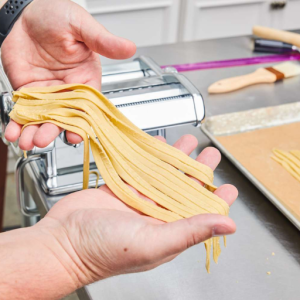
Pasta machines are available in different kinds to suit various requirements and tastes. There are three main categories – manual pasta makers, electric pasta makers, and pasta extruders.
- Manual Pasta Makers: These conventional appliances need to be cranked by hand to roll out and cut the dough into pasta. They usually come with adjustable rollers and different cutting attachments for making various shapes of pasta. Such devices are perfect for people who love making their own noodles or spaghetti from scratch but do not mind putting in some physical effort.
- Electric Pasta Makers: These machines automate both rolling and cutting stages, making them more convenient for frequent usage. Often equipped with several thickness settings and cutting styles, electric pasta makers are great for anyone who wants to save time in the cooking process without sacrificing taste quality.
-
Pasta Extruders: These units use dies with different forms through which dough is pushed to take the shape of pasta like fusilli, macaroni, penne, etcetera. Pasta extruders may be either manually operated or powered by electricity, but they are primarily designed for producing tube-shaped or other complicated types of pasta that cannot be achieved by means of rolling and cutting techniques alone.
The unique benefits associated with each type of maker enable one to select the most appropriate based on individual tastes, frequency of usage, and desired forms.
Overview of manual pasta maker designs
Commonly, hand-cranked manual pasta makers are strong and have adjustable rollers to flatten dough. Most of them use Chrome or stainless steel to allow for easy cleaning and durability. Typically, it includes a removable handle and clamp that secures the machine onto your countertop while you use it. Machines may also have standard attachments for cutting shapes such as fettuccine or spaghetti. Two popular models are the Marcato Atlas, which boasts its sturdy construction and user-friendly design, and the Imperia, known for being classic-looking and consistently reliable in performance. Some people buy these pasta makers because they let users control every step of making pasta so that each dish can be personalized, becoming an art piece.
Advantages of using an electric pasta machine
Many home cooks prefer electric pasta machines over manual ones for a few key reasons. One reason is that electric models take much less time than doing everything by hand, saving laborious hours when all someone wants are homemade noodles! Electric machines work faster because they do everything automatically: kneading, rolling out, cutting into sections… Another thing about these devices is their ability to make uniform thicknesses throughout batches – something difficult, if not impossible, with manual intervention, wherever possible. Furthermore, many electric pasta makers offer settings for different styles – including those that require minimal input from humans, such as penne rigate, where ridges on one side only need to be rolled across a flat surface once before drying naturally overnight on racks.
Specialized pasta maker attachments for unique shapes
The creators of specialized attachments for pasta machines intended them to go beyond the usual cuts and produce unique and complex shapes. You can opt to use a ravioli maker, which ensures that you have uniform sheets packed with any stuffing you want, a lasagne cutter, which makes narrower types of lasagna noodles, or a capellini attachment that makes angel hair pasta thin enough to be translucent. Furthermore, some attachments are configured to make regional pasta designs like orecchiette or gnocchi. These tools fit most electric and manual devices; they give home cooks versatility while trying out different homemade pasta recipes.
Which accessories enhance pasta making?
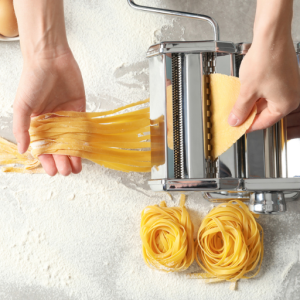
Many accessories help enhance pasta making. These include pasta drying racks that allow homemade noodles to dry evenly without sticking together, dough scrapers that can be used to cut and shape the dough, and pasta wheels or cutters that help create neat edges on ravioli and other stuffed pasta. Mixing bowls, measuring cups, and digital scales also ensure ingredients are measured accurately, while high-quality rolling pins assist in achieving the perfect thickness of dough required for different types of pasta. Together, these items help make the process of making pasta easier and produce better results.
Choosing the suitable pasta cutter for your needs
When choosing a pasta cutter, it is essential to think about what kind of pasta you want to make and your preferences. An electric or manual machine with different cutting attachments would be best for traditional long shapes like spaghetti, fettuccine, or linguine. If filled pasta such as ravioli is more up your street, then various molds are available that will give uniform shapes and seals every time. Regional specialties like orecchiette or gnocchi may require specific cutters designed for those shapes. Reading through online reviews can also indicate how well they work and their durability, so this may be worth doing before making any decisions.
Using a pasta drying rack effectively
To use a pasta drying rack well, ensure your newly cut pasta has enough flour to prevent sticking. Place the pasta in small uniform batches on the drying rack so air can circulate them properly. Ensure that the strands or shapes of pasta are spaced out evenly and not touching each other because they might stick together or dry unevenly. Put it in a ventilated place with no direct sunlight and moisture to avoid mold growing. Depending on what kind of pasta it is, it usually takes twelve to twenty-four hours before you can store or cook it. Turning or fluffing the pasta regularly may also aid in achieving even drying.
Must-have tools for homemade pasta
Several indispensable tools can significantly improve the process as well as the quality of homemade noodles:
- Pasta Machine: Manual or electric machines for rolling dough into thin sheets are invaluable when making fresh pasta at home. Marcato and Imperia brands have been highly recommended due to their durability and ease of use.
- Pasta Cutter: Versatile cutting attachments/tools like fluted pasta wheels, ravioli cutters, specialized gnocchi boards, etc., are crucial for making different types of shaped pasta easily recognizable by consumers who know them well enough already.
- Pasta Drying Rack: This is a must-have accessory for every kitchen where people frequently prepare meals with ingredients like eggs or wheat flour mixed and -dried uniformly without any clumping occurring afterward, etcetera. Bellemain/Norpro racks offer ample space while being stable throughout use.
With these tools, anyone interested in making their noodles will be able to do so more efficiently and with better results than if they did not have any additional equipment like those listed above.
Frequently Asked Questions (FAQs)
Q: What is the best manual pasta maker?
A: Marcato’s Atlas 150 pasta machine is widely regarded as the best manual pasta maker. Its durable stainless steel construction and ability to make various pasta types make it a favorite among enthusiasts.
Q: How do I use a Kitchenaid pasta attachment?
A: To use a Kitchenaid pasta attachment, simply attach it to your Kitchenaid stand mixer. Roll your dough to the desired thickness, feed it through the pasta sheet roller attachment, and then use the appropriate cutter for spaghetti, fettuccine, or other pasta shapes.
Q: Is the Marcato Atlas 150 pasta machine versatile?
A: Yes, the Marcato Atlas 150 pasta machine is highly versatile. It can create various pasta shapes and thicknesses, suitable for preparing traditional Italian dishes or gourmet pasta recipes.
Q: Which is considered the best electric pasta maker?
A: The Philips 7000 Series pasta maker is often considered the best electric pasta maker. It is user-friendly and can automatically knead, extrude, and cut pasta, making the process very convenient.
Q: What are the benefits of using a pasta maker attachment for Kitchenaid?
A: A pasta maker attachment for Kitchenaid, such as the 3-piece pasta roller and cutter set, provides the benefit of quickly and efficiently rolling and cutting pasta dough. It turns the stand mixer into a versatile pasta and noodle maker, perfect for home chefs.
Q: Can I make ravioli with the Atlas 150 pasta machine?
A: The Atlas 150 pasta machine has compatible accessories like a ravioli maker attachment. This allows you to create perfect ravioli with ease.
Q: Is the Rethone pasta maker attachment compatible with Kitchenaid mixers?
A: Yes, the Rethone pasta maker attachment is designed to be compatible with Kitchenaid stand mixers. It provides additional pasta-making options and enhances the mixer’s functionality.
Q: What should I consider the best electric pasta maker?
A: When searching for the best electric pasta maker, consider factors like ease of use, durability, the variety of pasta types it can produce, and user reviews. The Philips 7000 Series pasta maker is a popular and highly recommended choice.
Q: How does homemade pasta compare to store-bought pasta?
A: Homemade pasta often has a fresher taste and better texture than store-bought pasta. A pasta maker, such as the Atlas 150 pasta machine, allows you to create gourmet pasta dishes tailored to your preference.
Q: Can stainless steel pasta makers rust?
A: Quality stainless steel pasta makers, like the Marcato Atlas 150 pasta machine, are highly rust-resistant. However, to ensure longevity, they must be dried thoroughly after cleaning.












